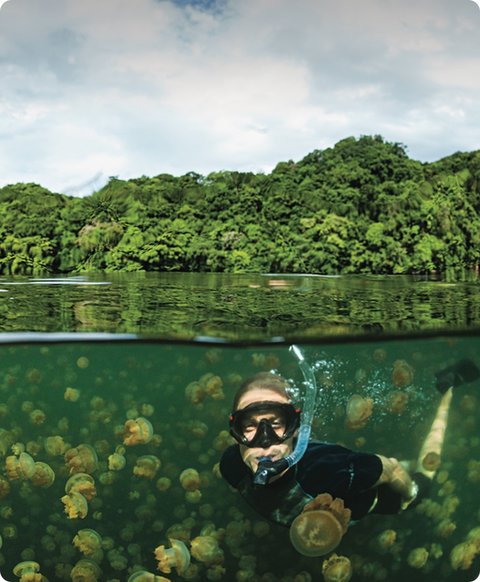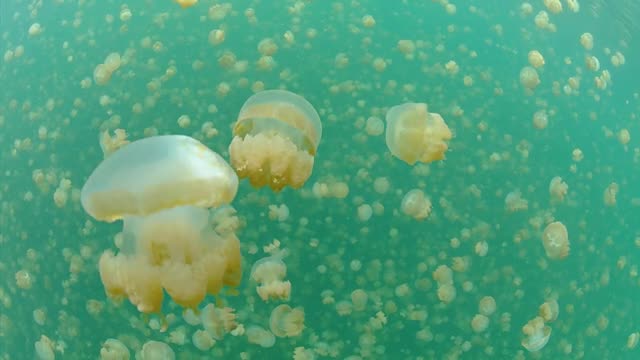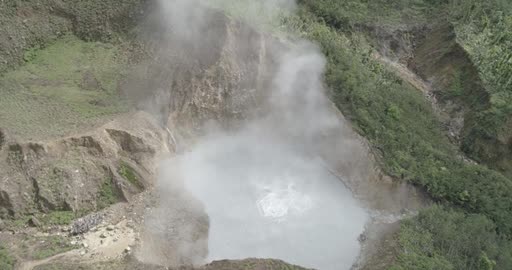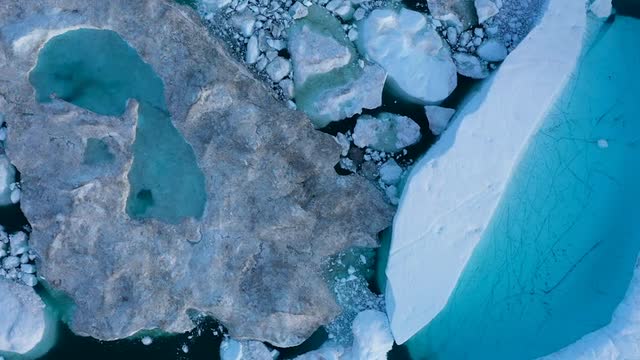
Ongeim’lTketau,EilMalkIsland, Palau
jellies
'JellyfishCentral'
Glidingglobesofgoldenjellies.Gobsofthem!That’swhatyou’llfindinOngeim’lTketau,onEilMalkIsland,Palau.ThistinylakeonatinyislandinthePacificOceanisknownaroundtheworldas"JellyfishCentral."Infact,manypeopledon’tevenknowthislake’sreal name.
Overthousandsofyears,thejelliesherehavelostmostoftheirsting.Whereelsecanyouswimamongcloudsofjellieswithoutgettingstung?Buthere’sthekicker:You’llhavetokeepupwiththejellies’busy schedule.
Inthemorning,thejelliesfloattotheeastsideofthelake.Intheafternoon,theybobbacktothewestside.Atbedtime,theyheadtowardthemiddle.Whythecommute?Sunlightisonereason.Tinyalgaeliveinthejellies’bodies.Thealgaegettheirenergyfromthesun,andthejelliesgettheirenergyfromthealgae.Scientiststhinkthejelliesarealsoavoidingshadowsalongtheshoreline,wheretheirarchenemy,theanemone, lives.
What'sCooking?
Everyonelikesnicewarmwater.ButBoilingLake,Dominica,isextreme.Itboils,justlikeapotofsoupona stove.
Dominica,likeotherislandsintheCaribbeanSea,isavolcano.Wheretherearevolcanoes,thereareoftenfumaroles:searinghotholeswhereheatandgasescape.BoilingLakefillsafumarole.Nowonderit’sboiling.There’shotmagma underneath!
GettingtoBoilingLakerequiresatoughhikethroughamuddyrainforest.Evenso,thelakeisahot spotforadventuroustourists.Theyscrambleupaslipperytrail.TheytrekthroughtheeerieValleyofDesolation,wheretheairisfilledwithsteamandsulfurthatsmellslikerotteneggs.Finally,theyreachacliffoverlookingBoilingLake.Theypeerthroughthemist,tryingtogetalookatthelake’schurningwater,andtheytryhardnottofall in.
aviewfromaboveofBoiling Lake

BoilingLake,Dominica

ameltwaterlakein Greenland
Thesemeltwaterlakesformedonanicebergin Greenland.
DowntheDrain
It’ssummeronGreenland’svast,miles-thickicesheet.Lakes,formedfrommeltingwater,dotthefrozensurface.Theysparklelikebluejewels.Thedarkertheblue,thedeeperthe lake.
ButsomeofGreenland’smeltwaterlakesplayalittlegameofnow-you-seeme,now-you-don’t.One,calledNorthLake,sometimesdrainsallatonce.Oneyear,all45billionliters(12billiongallons)ofitdisappearedintwohours!That’sabout18,000timesmorewaterthananOlympicswimming pool.
Scientistsfiguredoutwhathappens.Astemperatureswarm,theiceshifts.Thatopenshugecracks.Thelakesdraindownthroughthecracks.It’slikesomeonepulledtheplugonabathtub.Thewaterrunsallthewaytothebaseoftheicesheet.Thenitflowstowardthe sea.
Scientistshavefiguredoutsomethingelse,too.Theflowingwatermakestheiceaboveitmovetowardtheseafaster.Theyareworriedthatifsummersgettoowarm,Greenland’swholeicesheetmighteventuallyslip-slideaway.Heretoday,gone tomorrow.


